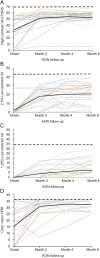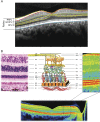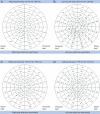Acute optic neuritis: Unmet clinical needs and model for new therapies
- PMID: 26236761
- PMCID: PMC4516397
- DOI: 10.1212/NXI.0000000000000135
Acute optic neuritis: Unmet clinical needs and model for new therapies
Abstract
Idiopathic demyelinating optic neuritis (ON) most commonly presents as acute unilateral vision loss and eye pain and is frequently associated with multiple sclerosis. Although emphasis is often placed on the good recovery of high-contrast visual acuity, persistent deficits are frequently observed in other aspects of vision, including contrast sensitivity, visual field testing, color vision, motion perception, and vision-related quality of life. Persistent and profound structural and functional changes are often revealed by imaging and electrophysiologic techniques, including optical coherence tomography, visual-evoked potentials, and nonconventional MRI. These abnormalities can impair patients' abilities to perform daily activities (e.g., driving, working) so they have important implications for patients' quality of life. In this article, we review the sequelae from ON, including clinical, structural, and functional changes and their interrelationships. The unmet needs in each of these areas are considered and the progress made toward meeting those needs is examined. Finally, we provide an overview of past and present investigational approaches for disease modification in ON.
Figures




References
-
- Toosy AT, Mason DF, Miller DH. Optic neuritis. Lancet Neurol 2014;13:83–99. - PubMed
-
- Beck RW, Cleary PA, Anderson MM, Jr, et al. ; Optic Neuritis Study Group. A randomized, controlled trial of corticosteroids in the treatment of acute optic neuritis. N Engl J Med 1992;326:581–588. - PubMed
-
- Cole SR, Beck RW, Moke PS, Gal RL, Long DT; Optic Neuritis Study Group. The National Eye Institute Visual Function Questionnaire: experience of the ONTT. Invest Ophthalmol Vis Sci 2000;41:1017–1021. - PubMed
-
- Beck RW, Cleary PA, Backlund JC. The course of visual recovery after optic neuritis. Experience of the Optic Neuritis Treatment Trial. Ophthalmology 1994;101:1771–1778. - PubMed
-
- Costello F, Hodge W, Pan YI, Eggenberger E, Coupland S, Kardon RH. Tracking retinal nerve fiber layer loss after optic neuritis: a prospective study using optical coherence tomography. Mult Scler 2008;14:893–905. - PubMed
Publication types
LinkOut - more resources
Full Text Sources
Miscellaneous
